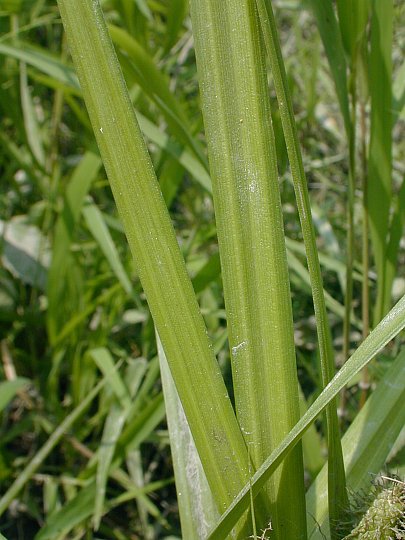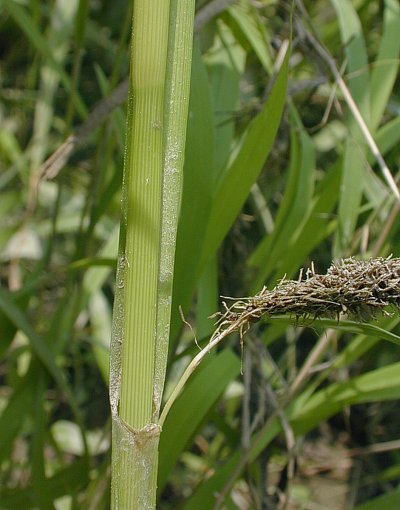Description: This perennial sedge consists of a tuft of basal leaves and one or more flowering culms up to 2½' tall; these culms have alternate leaves and leafy bracts near the inflorescence. The culms are light green, 3-angled, and glabrous. The leaf blades are up to 12" long and 10 mm. across; they are light green, glabrous, linear, shallowly furrowed, and scabrous (rough-textured) along their margins. The basal and lower leaf blades are usually arching, while the upper leaf blades are ascending. The leaf sheaths are mostly light green and glabrous – however, the apices of inner sheaths are membranous, forming concave upper margins. Each culm terminates in an inflorescence consisting of 3-8 pistillate spikelets and a terminal staminate spikelet (usually); less often, the terminal spikelet may be pistillate or gynecandrous (female florets & their perigynia above, male florets below, on the same spikelet). The pistillate spikelets are up to 2¼" long and ¾" across; they are short-cylindrical in shape and bristly in appearance because of the long beaks of their perigynia and their long pistillate scales. The perigynia are densely crowded together all around the spikelet. Individual perigynia are 4-5.5 mm. long and 1.5-2 mm. across; they are oblanceoloid to obovoid in shape, light green (while immature), and glabrous. Except for their long slender beaks (1.5-2 mm. long), the upper surfaces of these perigynia are relatively flat.

The pistillate scales are up to 10 mm. long and narrowly linear in shape; they are much longer than their perigynia. The pistillate spikelets are sessile to short-stalked; they are often partially hidden by the upper leaves and leafy bracts. The pistillate floret of each perigynium has a long style with 3 exerted stigmata; this style may be straight or sinuous (somewhat curly). The narrow staminate spikelet is up to 2" long; it becomes brown and withered shortly after releasing its pollen. The scales of the staminate spikelet are narrowly linear. The staminate spikelet is usually exerted a little above the uppermost pistillate spikelets on a short peduncle up to 2" long. The blooming period typically occurs during early to mid-summer, lasting about 2 weeks; the florets are cross-pollinated by the wind. The pistillate spikelets change color from green to yellowish brown as their achenes mature; there is one achene per perigynium. After disarticulation from the spikelets, the inflated perigynia have the capacity to float on water, by which means they are introduced into new areas. Mature achenes are 1.5-2.0 mm. long, 1.0-1.5 mm. across, obovoid in shape, 3-angled, and glabrous. The root system is fibrous and short-rhizomatous. Clonal offsets often develop from the rhizomes.

Cultivation:
The preference is partial to full sun, wet to moist conditions, and
fertile soil that is loamy or silty. Standing water or temporary
flooding is tolerated; when this happens, miscellaneous debris often
becomes snagged on the prickly pistillate spikelets. This sedge is
occasionally attacked by slugs.
Range & Habitat:
The native Frank's Sedge is occasional to locally common in southern
and central Illinois, while in the northern section of the state it is
uncommon or absent (see Distribution
Map).
Illinois lies along the northern range-limit of this species. Habitats
include openings in floodplain woodlands, wet dolomite prairies,
sloughs, fens and seeps, sedge meadows, low areas along rivers and
ponds, and roadside ditches. This sedge can be found in both
disturbed and higher quality wetlands; sometimes it occurs in great
abundance.

Faunal
Associations:
Insects that feed on wetland sedges (Carex spp.) include
sedge grasshoppers (Stethophyma
spp.), semi-aquatic leaf beetles (especially Plateumaris spp.), Sphenophorus costicollis
(Sedge Billbug), seed bugs (Cymus
angustatus, Oedancola
dorsalis), a shield bug (Eurygaster alternata),
miscellaneous aphids, leafhoppers (especially Cosmotettix spp.),
stem-boring larvae of flies (Cordilura
varipes, Loxocera
cylindrica), larvae of the fly Hydrellia griseola
(Lesser Rice Leafminer), caterpillars of the butterfly Satyrodes eurydice
(Eyed Brown), caterpillars of skippers (Euphyes spp., Poanes spp.), and
larvae of various moths. The seeds and/or spikelets of wetland
sedges are an
important source of food to various ducks, rails, and granivorous
songbirds (see Bird
Table).
The Canada Goose also eats the foliage of wetland sedges (personal
observation). The muskrat occasionally feeds on the rhizomes, culms,
and young shoots.
Photographic Location:
Along a drainage ditch at Judge Webber Park in Urbana, Illinois.

Comments: This is a rather large and stout sedge that is fairly easy to identify. It belongs to a small group of & sedges (Carex spp.) with oblanceoloid to obovoid perigynia (resembling narrow bell peppers). The perigynia of such sedges often have long narrow beaks at their apices, providing their pistillate spikelets with a prickly appearance. What distinguishes Frank's Sedge from other members of this group are its linear pistillate scales; they are much longer than the bodies of its perigynia. In contrast, the pistillate scales of other sedges in this group (e.g., Carex squarrosa, Carex typhina) are no longer than the bodies of their perigynia. Another difference is the position of the staminate florets: Frank's Sedge usually produces a terminal staminate spikelet that is separate from the pistillate spikelets, while Carex squarrosa and Carex typhina always produce staminate florets underneath the pistillate florets on the same spikelets.